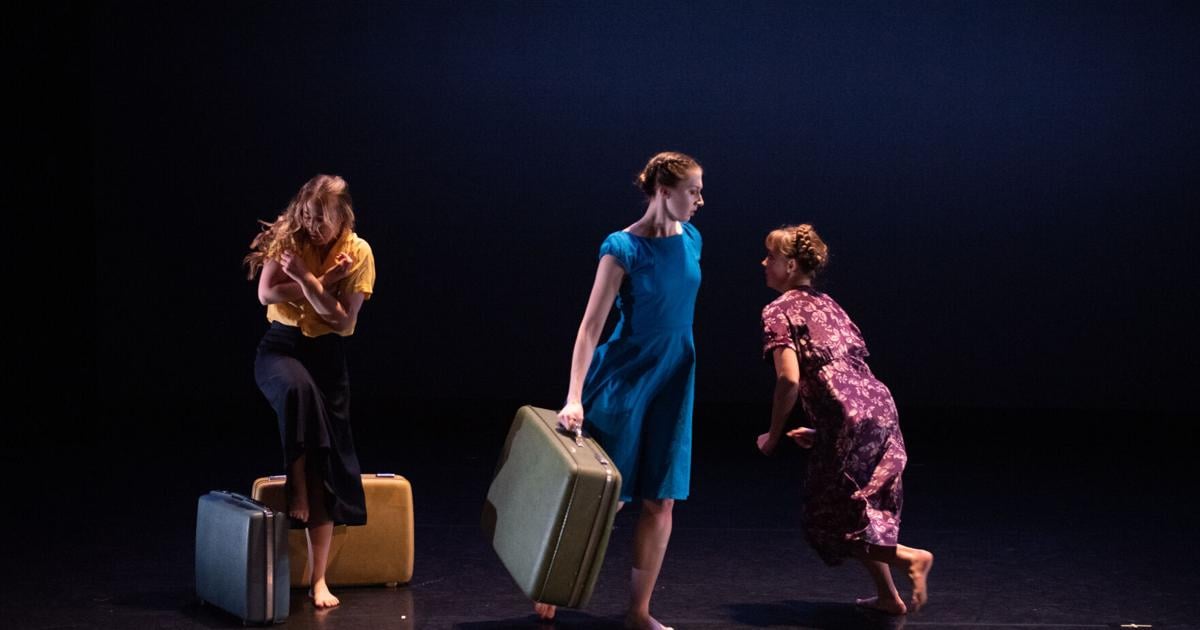
Nine student dancers in uniform navy bodysuits lay face down on the vinyl Marley floor, pounding their fists and bobbing their heads in unison.
What unfolds is UW-Madison alumna and guest arist Taryn Vander Hoop’s “Fever Pitch,” a masterful work that interrogates the uniquely modern tension between homogeneity and freedom. The piece is reason enough to attend the University of Wisconsin-Madison’s Dance Department’s Faculty Concert Fall 2023 at Lathrop Hall.
The evening includes five works total, all from professors and performed by students, offering different impressions of what it means to be in a group. Performances continue Nov. 17-18 and Nov. 30-Dec. 2.
A mechanical noise opens the show, and stage lights reveal a dancer behind the wheel of a child-size black Range Rover. The playful nature of its presence is juxtaposed by the serious demeanor of the other four dancers who appear on stage. A faint cityscape is projected behind them as they interact (or not) with the car and each other.
The same dancer drives it around to different spots, only to abandon it again. Neutral costumes of white, black, and gray contribute to a subdued aesthetic of Karen McShane-Hellebrand’s “Triumph is in the Persistence.”
The fourth wall is lifted in Kate Corby’s “Subject to Chance (an experiment),” when the four dancers perform pre-rehearsal chatter in front of the stage before recruiting audience members to roll giant inflatable dice that will determine which version of a pre-set roster of lights, music, and costumes will accompany their performance.
The piece drops into formalism as soon as such elements are in place, and the dancing that follows is measured, solemn, and rote. Three folding chairs become part of the ensemble. What results is a dance that offers the element of chance without the element of risk.
Jin-Wen Yu’s piece “In This World” offers virtuous dancing and a rich landscape of movement. Flowing two-piece teal costumes extend every sweeping motion of the dancers to create an image of water. Three distinct sections delineate a shift in focus from group synergy to individual singularity, as dancers disappear and emerge with unique shirts and then unique bottoms, presumably from their own closets. The moment when Evelyn Henriksen and Emma Miquelon burst out from stage right, each hopping on one leg with the other extended before collapsing into the ground, was electric.
After an intermission, we are confronted with the largest group of the evening, all dressed in black and white tones for Liz Sexe’s “Parallax.” Their movements are frenetic and repetitious, creating a moving image of anxiety and steadiness personified.
Most powerful is a formation along the diagonal of the stage, with dancers staggered and facing each other as they move intently and urgently through the same sequences of gestures. What has them so consumed?
The final piece of the evening by Vander Hoop is a shining example of the singular power of dance to embody and excavate an idea. Technology, conformity, passion, suppression, catharsis, melancholy, and joy are all ingredients in the cocktail of her meticulously constructed and relentlessly performed work.
While the entire ensemble is compelling, individually and collectively, Blair Odders’ stage presence is singular in its intensity. The piece, made over the course of Vander Hoop’s three-week residency, feels like a rare moment when the Venn diagram of choreographer, performers, time, and place converge to produce deeply urgent and salient work. I am grateful to have witnessed it.
Choreographer Miguel Gutierrez said, “the easiest way to notice the difference between people is to make them do the same thing.” This concert is a rich opportunity to observe such a phenomenon.
